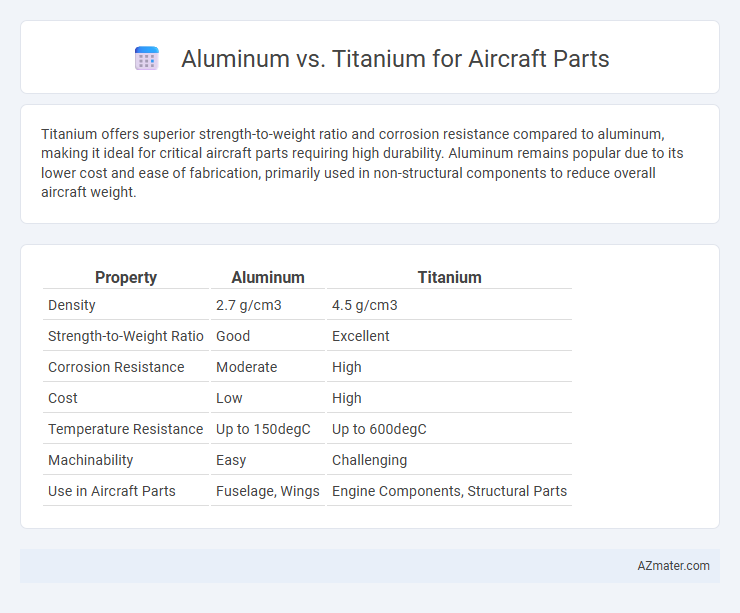Titanium offers superior strength-to-weight ratio and corrosion resistance compared to aluminum, making it ideal for critical aircraft parts requiring high durability. Aluminum remains popular due to its lower cost and ease of fabrication, primarily used in non-structural components to reduce overall aircraft weight.
Table of Comparison
| Property | Aluminum | Titanium |
|---|---|---|
| Density | 2.7 g/cm3 | 4.5 g/cm3 |
| Strength-to-Weight Ratio | Good | Excellent |
| Corrosion Resistance | Moderate | High |
| Cost | Low | High |
| Temperature Resistance | Up to 150degC | Up to 600degC |
| Machinability | Easy | Challenging |
| Use in Aircraft Parts | Fuselage, Wings | Engine Components, Structural Parts |
Introduction: Aluminum vs Titanium in Aircraft Engineering
Aluminum and titanium are critical materials in aircraft engineering, each offering distinct advantages in performance and durability. Aluminum alloys provide lightweight strength and excellent corrosion resistance, making them ideal for structural components. Titanium boasts superior strength-to-weight ratio and exceptional resistance to high temperatures, essential for engine parts and areas exposed to extreme stress.
Material Properties: Aluminum and Titanium Compared
Aluminum offers a lightweight structure with excellent corrosion resistance and good thermal conductivity, making it ideal for aircraft fuselage and skin panels where weight savings and durability are critical. Titanium provides superior strength-to-weight ratio, exceptional fatigue resistance, and high corrosion resistance in extreme environments, making it suitable for engine components and airframe sections exposed to high stress and temperature. While aluminum is more cost-effective and easier to machine, titanium's higher melting point and enhanced mechanical properties justify its use in high-performance aerospace applications.
Weight and Density Differences
Aluminum has a density of approximately 2.7 g/cm3 compared to titanium's higher density of around 4.5 g/cm3, making aluminum significantly lighter for aircraft parts. Despite its greater density, titanium offers superior strength-to-weight ratio and corrosion resistance, allowing for thinner, lighter components in critical structural applications. The trade-off between aluminum's low density and titanium's enhanced durability influences material selection based on specific weight and performance requirements in aerospace engineering.
Strength and Durability Factors
Titanium offers superior strength-to-weight ratio compared to aluminum, making it ideal for critical aircraft parts that require high structural integrity. Its excellent corrosion resistance and fatigue strength enhance durability, especially in harsh aerospace environments. Aluminum, while lighter and more cost-effective, typically requires additional treatment or alloying to match titanium's long-term resilience under stress.
Corrosion Resistance and Longevity
Titanium offers superior corrosion resistance compared to aluminum, making it ideal for harsh aerospace environments exposed to moisture and salt. Its ability to maintain structural integrity without degrading extends the longevity of aircraft parts, reducing maintenance costs and downtime. Aluminum, while lightweight and cost-effective, corrodes more easily and often requires protective coatings to enhance durability in aircraft applications.
Machinability and Manufacturing Considerations
Aluminum offers superior machinability due to its lower hardness and excellent thermal conductivity, enabling faster cutting speeds and reduced tool wear compared to titanium. Titanium's high strength-to-weight ratio and corrosion resistance come with manufacturing challenges, including slower machining rates and the need for specialized tooling to prevent work hardening and tool damage. Choosing aluminum for complex aircraft parts can reduce production time and costs, while titanium is preferred where performance under extreme conditions outweighs machining difficulties.
Cost Analysis: Aluminum vs Titanium
Aluminum offers a lower initial material cost compared to titanium, making it a more cost-effective choice for large-scale aircraft part production. Titanium, while significantly more expensive per pound, provides superior strength-to-weight ratio and corrosion resistance, which can reduce maintenance costs and extend component lifespan. Analyzing total lifecycle costs reveals aluminum suits budget-sensitive projects, but titanium delivers long-term value through durability and performance in critical aircraft components.
Typical Applications in Aircraft Parts
Aluminum is extensively used in aircraft fuselage, wing structures, and skin panels due to its lightweight and excellent corrosion resistance. Titanium finds typical applications in high-stress components such as engine parts, landing gear, and fasteners because of its superior strength-to-weight ratio and resistance to extreme temperatures. Both metals are chosen to optimize performance, with aluminum favored for large surface areas and titanium for structural and thermal critical parts.
Environmental Impact and Sustainability
Titanium offers superior corrosion resistance and longer lifespan compared to aluminum, reducing the frequency of part replacements and minimizing waste in aircraft manufacturing. Aluminum is more energy-intensive to produce but excels in recyclability, with a recycling rate of over 90%, significantly lowering its environmental footprint. Choosing titanium enhances durability and reduces environmental degradation, while aluminum supports circular economy goals through efficient recycling processes.
Conclusion: Choosing the Right Material for Aircraft Parts
Titanium offers superior strength-to-weight ratio and corrosion resistance compared to aluminum, making it ideal for critical aircraft parts exposed to high stress and extreme conditions. Aluminum remains a cost-effective choice with excellent machinability and good strength, suitable for less demanding structural components. Selecting the right material depends on specific performance requirements, budget constraints, and environmental factors impacting the aircraft part's lifespan and safety.

Infographic: Aluminum vs Titanium for Aircraft Part
 azmater.com
azmater.com